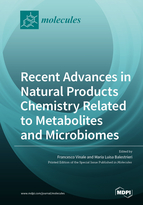Recent Advances in Natural Products Chemistry Related to Metabolites and Microbiomes
A special issue of Molecules (ISSN 1420-3049). This special issue belongs to the section "Natural Products Chemistry".
Deadline for manuscript submissions: closed (9 December 2019) | Viewed by 42095
Special Issue Editors
2. Istituto per la Protezione Sostenibile delle Piante, Consiglio Nazionale delle Ricerche (IPSP-CNR), 80055 Portici (NA), Italy
Interests: biological control; Trichoderma; secondary metabolites; metabolite characterization; plant pathogens
Special Issues, Collections and Topics in MDPI journals
Interests: aging; oxidative stress; nitric oxide; endothelial cells; endothelial progenitor cells; angiogenesis; inflammation; cell senescence; apoptosis; atherosclerosis; diabetes, endothelial dysfunction, sirtuins and cardiovascular disease; natural products; betaines; health; bioactive compounds; free radicals; antioxidants; ergothioneine; cell cycle; cancer-related biochemical pathways; cell proliferation; senescence; cancer cell death; epigenetic regulation; sirtuins and cancer
Special Issues, Collections and Topics in MDPI journals
Special Issue Information
Dear Colleagues,
The microbiome is generally referred to as the collective microbial genome found in a particular habitat, while the microbiota is the set of microorganisms living in a specific environment. However, some authors use the term “microbiome” also to indicate the microbes that co-exist within complex communities. In this Special Issue, the term “metabolites” refers only to the small molecules showing important functions in biological processes, with particular emphasis on secondary metabolites. The set of low-molecular-weight metabolites that are produced by organisms is defined as the “metabolome”. The components of the metabolome represent the end products of gene expression and define the biochemical status of an organism.
In the present Special Issue, the following topics will be covered:
- isolation of novel microbial compounds using metabolomic approaches;
- molecules and metabolomes related to agricultural applications (crop and animal productions);
- microbiomes and related natural products with beneficial effects in agriculture;
- plant metabolites with bioactive properties;
- influence of beneficial microbes and/or their metabolites on plant metabolomes;
- microbial metabolites involved in plant or animal interactions;
- influence of production technologies on animal metabolomes and microbiomes.
Full research papers, reviews, short communications reporting the finding and the characterization of molecules, metabolomes, and related microbiomes and showing their potential for agricultural applications both directly (e.g., increased nutritional value of crops) and indirectly (e.g., effects on the environment, agricultural practices, etc.), as well as their effects on health are invited for this editorial project.
Dr. Francesco Vinale
Prof. Maria Luisa Balestrieri
Guest Editors
Manuscript Submission Information
Manuscripts should be submitted online at www.mdpi.com by registering and logging in to this website. Once you are registered, click here to go to the submission form. Manuscripts can be submitted until the deadline. All submissions that pass pre-check are peer-reviewed. Accepted papers will be published continuously in the journal (as soon as accepted) and will be listed together on the special issue website. Research articles, review articles as well as short communications are invited. For planned papers, a title and short abstract (about 100 words) can be sent to the Editorial Office for announcement on this website.
Submitted manuscripts should not have been published previously, nor be under consideration for publication elsewhere (except conference proceedings papers). All manuscripts are thoroughly refereed through a single-blind peer-review process. A guide for authors and other relevant information for submission of manuscripts is available on the Instructions for Authors page. Molecules is an international peer-reviewed open access semimonthly journal published by MDPI.
Please visit the Instructions for Authors page before submitting a manuscript. The Article Processing Charge (APC) for publication in this open access journal is 2700 CHF (Swiss Francs). Submitted papers should be well formatted and use good English. Authors may use MDPI's English editing service prior to publication or during author revisions.
Keywords
- secondary metabolites
- microbial metabolites
- microbiome
- metabolome
- agriculture
- health benefits








